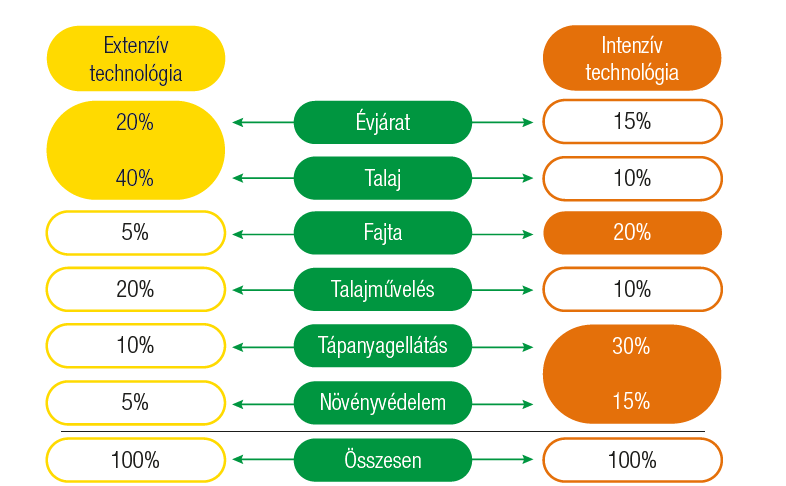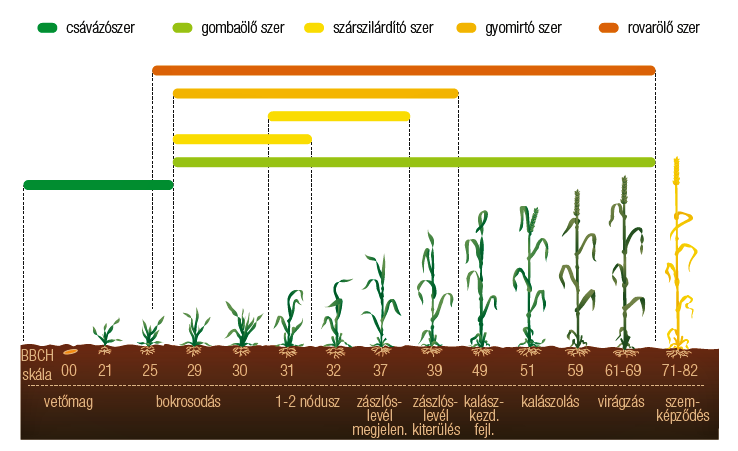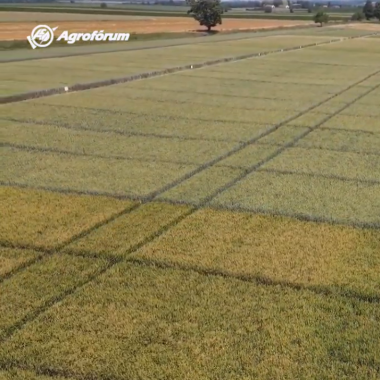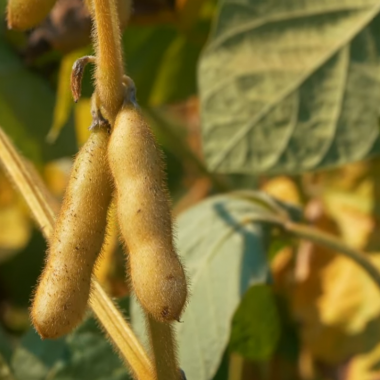How to achieve 9-10 tons of wheat per hectare?
The primary aim of breeders is to increase the genetic potential of varieties. This genetic potential will be then inherent to the given variety. The physical manifestation of the variety is the seed, sold to growers. The percentage that can be actually realised from the highest potential yield depends on many factors; some of these can hardly be controlled by human activities while we may profoundly influence others by accurately keeping to the prescribed processes.
In intensive cultivation, seasonal variations and soil factor have a lesser impact on yields. In this case, fertilisation and pest management have increased importance. Selecting the right variety is also essential. The figure below compares the roles various cultivation factors play in extensive and intensive cultivation.
Cultivation factors in wheat farming

(Source: Péter Pepó, 2017)
It is important to understand that maximum yields have been constantly decreasing due to factors beyond our control as well as inappropriate decisions. We would therefore like to draw your attention to the most important factors.
The production technology of high-yielding varieties such as Cellule, Basilio or Frenetic differs in many respects from the wheat cultivation practices traditionally used in Hungary. When implementing these technologies, an effort should be made to harmonise and intensify the various technological elements. Traditionally, little attention is paid to the autumn development of winter cereals. However, in order to achieve record yields, it is important that wheat enters the winter in the right developmental stage. To do this, sowing at the end of September or in early October is essential. New varieties need a higher GDD of around 100°C per leaf, which allows earlier sowing and a longer tillering period. However, tillering should be supported by other technological elements, too. This period is crucial for plant protection, with special regard to weed control and virus vector control. In addition to the duration of the autumn period, the availability of sufficient nitrogen to provide for proper development also determines the rate of tillering. Early sowing is important, but you must not forget that cereals are long-day crops, and may grow too rapidly when sown too early.
Tillage
The role of tillage in the production of cereals is to ensure that all the necessary preconditions are provided for the development of the root system. The depth of the primary tillage should be about 18-22 cm i.e. not too deep and adapted to the previous crop and the amount of stubble. Unfortunately, the number of ideal pre-crops for winter wheat is rather low so this technological element requires increased attention. To control Fusarium after a maize pre-crop, the soil should be turned by tillage. To provide for a high quality seedbed, tillage should consider earlier sowing dates while preserving soil moisture and reducing the interval between primary cultivation and seedbed preparation. A seedbed properly prepared for sowing is free of weeds, finely crumbled, settled and has sufficient water reserves.
Sowing
To achieve yields as high as of 9 to 10 tonnes, sowing should be scheduled early, to some date between 25 September and 10 October, so that the crop may reach a suitable stage of development, with five or more leaves, by the time winter comes. Seeds should be should be sown at a depth of 3 to 5 cm, depending on the moisture content of the seedbed. The recommended seeding rate is 3,6-4,4 million seeds/ha corresponding to 180-220 kg/ha depending on 1000 kernels weight. Always check the sowing depth because uneven sowing results in uneven emergence, which in turn will affect the overall development of the crop.
Always sow premium quality, certified and sealed seed!
Seed dressing provides protection against various pathogens and pests during the early development stages. All Isterra seeds are treated with fungicides containing two active ingredients and, where necessary, also an insecticide against soil-dwelling pests; for the latter purpose, cypermethrin is a perfect active ingredient.
Weed management
The successful production of winter cereals essentially depends on whether the field can be kept free of weeds up until harvest time. As high-yielding modern varieties need to be sown early, favourable weather conditions during the autumn will not only favour the development of the crop but also that of weeds, resulting in increased competition. Lower seeding rates will also diminish the weed suppression capacity of the crop at the early stages. hence, weeds should be controlled in the autumn, too. The most important weed management task in the spring is still the control of dicot weeds. Use systemic herbicides against early flowering T1 weeds early in the spring, before they bloom.
Fertilisation
Over the last decade, the genetic background of nutrient utilisation has developed at a very rapid pace in the case of modern varieties. Proper fertilisation and the use of fungicides are the most important aspects in increasing yields. Fertilisation should always be preceded by meticulous soil sampling and the development of a fertilisation plan based on the results. The two most important features to consider when discussing wheat yields are the number of grains per unit area and the weight of each grain. The sufficient number of leaves and shoots, healthy foliage, increasing the number of grains per ear and the size of the grains are the key to high yields.
Base dressing
Nitrogen and potassium are the key nutrients when it comes to maintaining high wheat yields. Phosphorus is required in an amount similar to that of sulphur. It is important that the soil is fully replenished with phosphorus and potassium, as these elements play a major role in plant development in the spring, after they have become available for the plants. The macro-nutrients and micro-nutrients having the strongest effect on leaf numbers are nitrogen + phosphorus + sulphur and manganese + zinc, respectively.
Top dressing
Nitrogen, potassium and magnesium are essential for maintaining the health of the foliage. Potassium plays an important role in good lodging resistance. By the time the first node appears, more than half of the total nitrogen should be available in the soil, including the nitrogen applied in the autumn. The number of grains per ear may be increased by applying nitrogen, potassium, manganese, zinc, copper and boron. Scheduling the next dressing is defined by the beginning of flowering. By the time this phenological stage starts, almost all the nitrogen planned for the given yield should be available. The 1000 kernel weight of wheat is increased by manganese and zinc, in addition to nitrogen, phosphorus and potassium. In milling wheat, nitrogen applied at the time of ear emergence significantly improves the nutritional values of the crop, especially the protein content of the grains.
Foliar fertilisation is an important part of the technology, with special regard to providing micro-nutrients. If the uptake of macro-nutrients (NPK) is inhibited (in the case of drought), plants may be supplied with nutrients that can be absorbed immediately through the foliage.
Fungicide treatments
Traditionally, cereals used to be treated against fungal diseases once a year; however, control technologies including two or even three treatments and thus offering increased safety and better yields, are gaining popularity. With extreme weather events becoming more common, fungal diseases can often only be sufficiently controlled by spraying with 2-3 times. The first treatment serves the purpose of preventing early foliar diseases. The most dangerous fungal pathogens are stripe rust and various leaf spots, so the second treatment aim at protecting the upper leaves (the flag leaf in particular) against rust and spot diseases. If you want maximum yield, these upper leaf levels should be given maximum protection when they are fully developed i.e. when the flag leaf is unfurled. The third treatment targets the ears; at this point, fungicides are applied at full flowering, preventing the spreading of Fusarium on the ears and the reducing toxin concentrations in the grains.
Winter wheat crop protection technology

Growth regulation
In modern wheat production, growth regulation to increase lodging resistance is an important technological element to achieve maximum yields. Several products with different mechanisms of action and consequently different modes of application are available. To properly schedule the application, temperature and the developmental stage of plants should be carefully considered. Using combinations of products diversify application alternatives.
Insecticide treatments
From the aspect of control, the most important pests are cereal leaf beetles, cereal aphids and shield bugs. These can be controlled from the time invading the field until the soft dough stage. Shield bugs may be controlled above an air temperature of 10 C.
Winter wheat should be harvested when fully mature, at a moisture content of 13-15%. Immediately after harvesting, the stubble should be broken at a shallow tillage depth and then closed, to trigger the germination of scattered seeds. It is advisable to keep the field free of weeds to prevent the presence of pests and provide for the success of the next crop.
.


